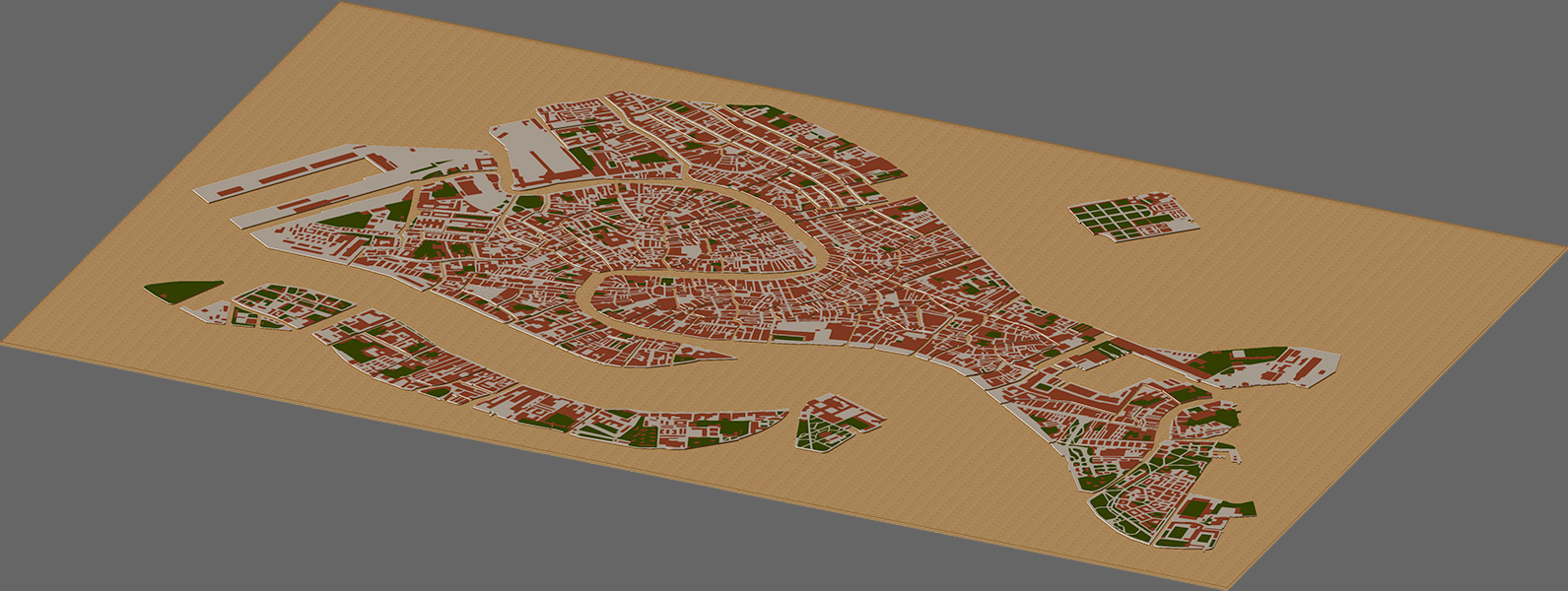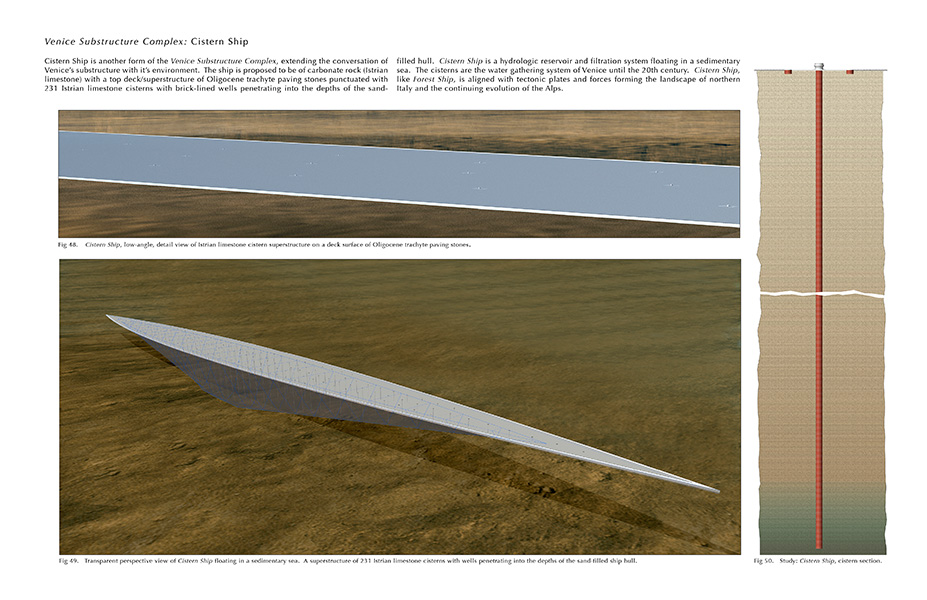Research/Studies/Concepts/Antecedents
Exemplary research and studies for examining selected subterranean structures and foundations of Venice, Italy, as a function of their geologic context, origin and displacement of and within natural systems/materials dated back to the Tethys Sea and Alpine orogenic events.
The Venice Substructure Complex is characterized as a conformable Anthropocene, intrusive suite and super-positioned stratigraphic system. An integrated wooden piling system is understood as a unique, submerged, geo-sylvan environment displaced from its original sub-aerial habitat.
The Venice substructure is seen as a sea/land environment constructed of sea/land environments
of
Mesozoic, Tertiary Quaternary and Anthropocene ages.
Project Description:
Venice Substructure Complex (VSC), describes a unique, structural system underlying the city of Venice: an inverted, hidden forest. The origin of this assemblage, as considered in this study, is the contemporary landscape of Venice extended in geographic, geologic, climatic and cultural terms over an area of central and southern Europe. The configuration and materiality of the current Venetian landscape was shaped by the transformation of other, earlier, landscapes and seascapes as far back as the Jurassic Period. This transformation and the unique character of VSC evokes a conversation between the foundations of Venice with it’s contemporary and historical environment. Further into this investigation, several analogs and concepts for envisioning ecological and artistic responses to this dialog are also set forth. The interaction of time and place within the Venetian terrain suggests analogs between natural and human activity, process and meaning. Materials displaced in time and space are a primal mechanism of change in the construction of landscapes, seascapes and cities, this theme in both natural and human systems is further echoed in this document.
Plate tectonic engagement of the Eurasian and African plate during the Mesozoic and Cenozoic set the stage for the formation of Italy, the Alps and Adriatic Sea, formative elements of the Venice landscape. As a result of this larger geologic dynamic, the upper 900 meters of Venetian lagoon sediments were deposited from natural terrestrial and marine sources in Quaternary time. In Anthropocene time the VSC was deposited on and into the upper layers of the lagoon sediments. Wooden foundation pilings are a primary component of the VSC. Creating a stable foundation for the architecture of Venice, a system of tree trunks taken from local forests and the foothills of the Alps were intruded into the sediments. The pilings were capped with wood of the same source and Jurassic era limestones primarily from the Istria peninsula of Croatia across the Adriatic from Venice. Layered onto this stone strata were fired bricks of primarily Pleistocene glacial sediments. The final element of the VSC, forming the streets (calle) and ground-floor surfaces at the top level, shallow, horizontal strata of primarily Oligocene trachyte and Cenozoic carbonates were set in place.
|
The image of an invisible forest preserved by it’s anaerobic environment, displaced geographically and atmospherically from it’s aerobic origin of local terrestrial terrain and Alpine foothills, encased in a sedimentary matrix of complex origin (Tethys Ocean sediments altered by plate tectonics of the Alpine Orogeny and subsequent glacial depositional and erosional processes) is compelling. Relating back to the flora and fauna of the Tethys Sea, Alpine soils derived from that mineral/bio-legacy form the nutrient systems of the forests themselves. The bricks of Alpine erosional sediments of Pleistocene age are local to Venice but also share geochemical and paleo-climatic relationships with the wooden pilings. The Istrian limestone directly makes a geologic connection with it’s origin as carbonate sediments/reefs of the Mesozoic, Tethys/Neo-Tethys seas, consolidated by tectonic activity as part of the Apulian/Adriatic plate and associated Alpine and Dinaridian orogenies. This project also investigates conceptual ideas for the return of the displaced, anerobic and submerged forest into a subaerial respiratory environment similar to it’s origin; a re-distribution of the pilings as living trees as a parallel forest in current and future time. The VSC (and all of Venice) considered as a buoyant structure floating in the sediments of the Venice lagoon conjures elemental ship-like structures of environmental change and transit as in Forest Ship and Cistern Ship. The change in density of the piling placement for support of architecture into a diffuse habitat of a healthy, living forest becomes an evolution of the conversation of the city with it’s environment.
Venice Substructure Complex, as described above, is characterized as a geologic and metaphorical formation. This description is similar in nature and perception to other projects such as the San Francisco Wharf Complex, 2012, where the wharf system of San Francisco is seen as a geologic structure in it’s own right with Anthropocene/geologic, morphologic, depositional, transport and displacement analogs and ensuing conversations. Similar concepts arise between the Venician and San Francisco sites for possible environmental expressions of corresponding research. For Venice as for many other sites specific/literal information is often incomplete or conflicting. In the case of the wooden piling system beneath Venice several models of the piling layout and configuration were compared or consolidated to arrive at an general idea of the scope of the materiality and structure of the cities subsurface and their role in the larger formation. This study in not intended to be authoritative or act in the place of science, but as an exploration linking science, observation, history and site to reveal latent and poetic conversations of Land and Sea. Examples of additional, relevant antecedents that engage site, materiality and research include: the kiln/site projects, 1979-92, Vanishing Ship (Greenhouse for Lake Lahontan), 1987, Metafossil.., 1992, Deep Gradient/Suspect Terrain.., 1993, the works in the exhibition, Rising Sea.., 1998, Holocene Terrace and related multi-beam sonar concepts, 1998-2016, Holocene Passage, 2002, Original Depositional Environment, 2002, and Rapson Group/Site Index, 2004-13, among numerous others.
The Sea within the Land / The Land within the Sea / The Land within the Land / The Sea within the Sea
A special thanks to the Emily Harvey Foundation for the time, space and place to carry out this research and for the San Francisco Art institute for time and support in the form of a sabbatical semester, Spring 2016. |




